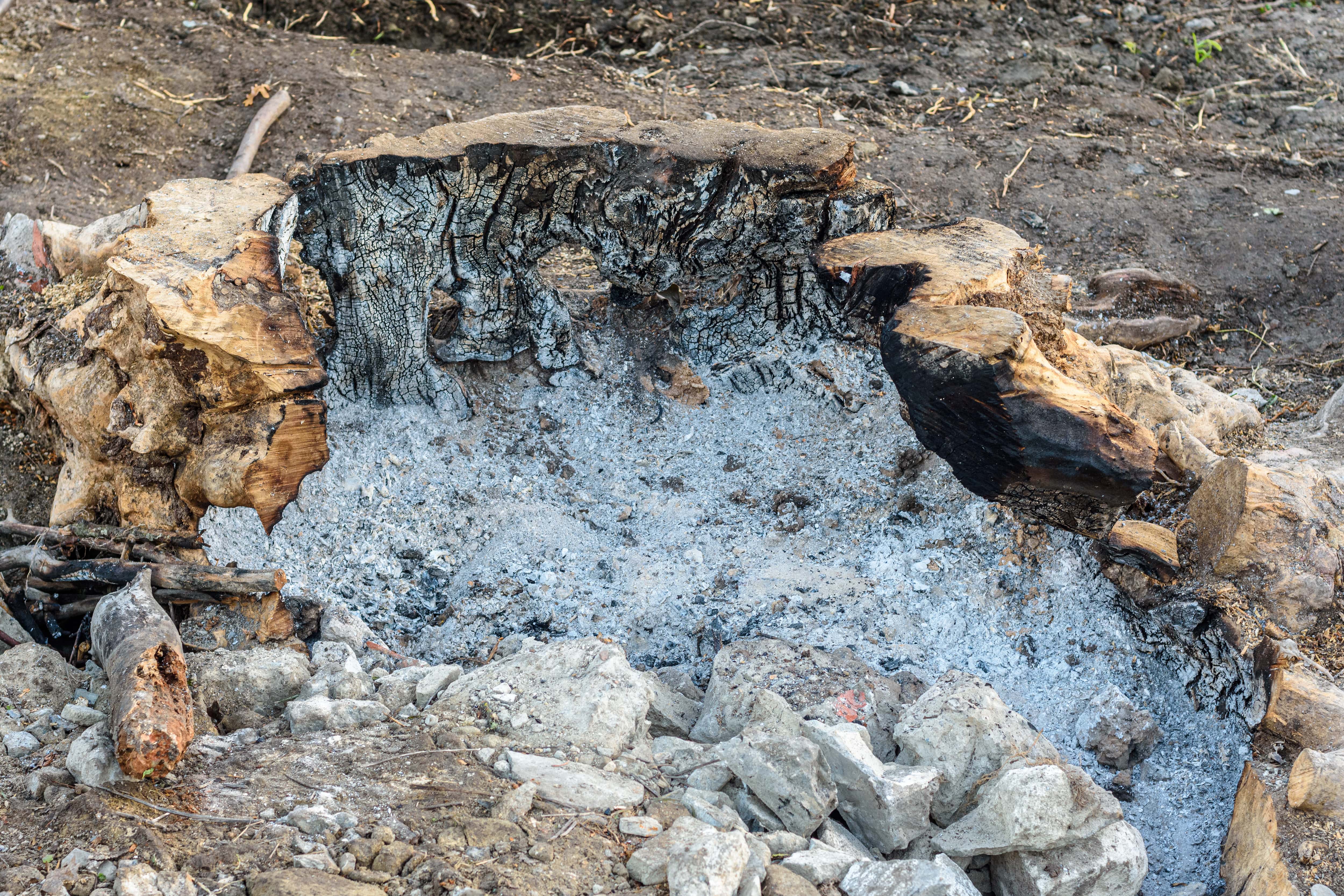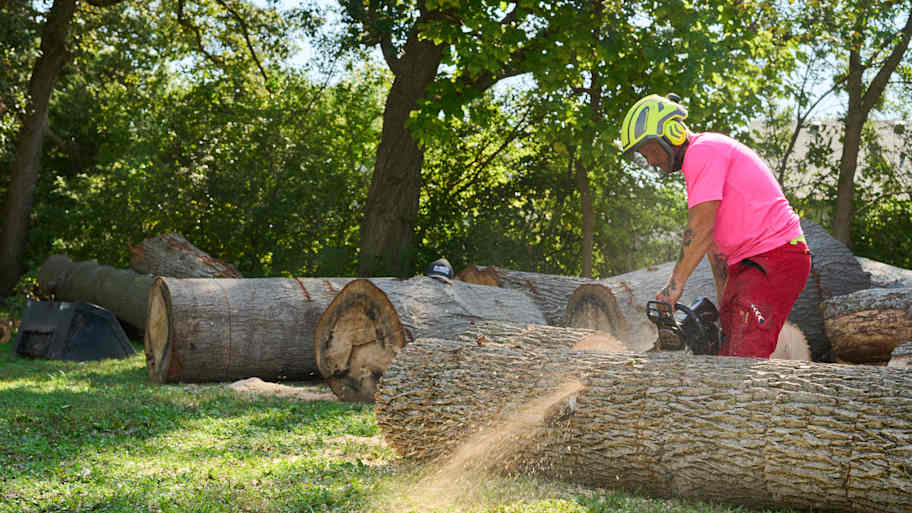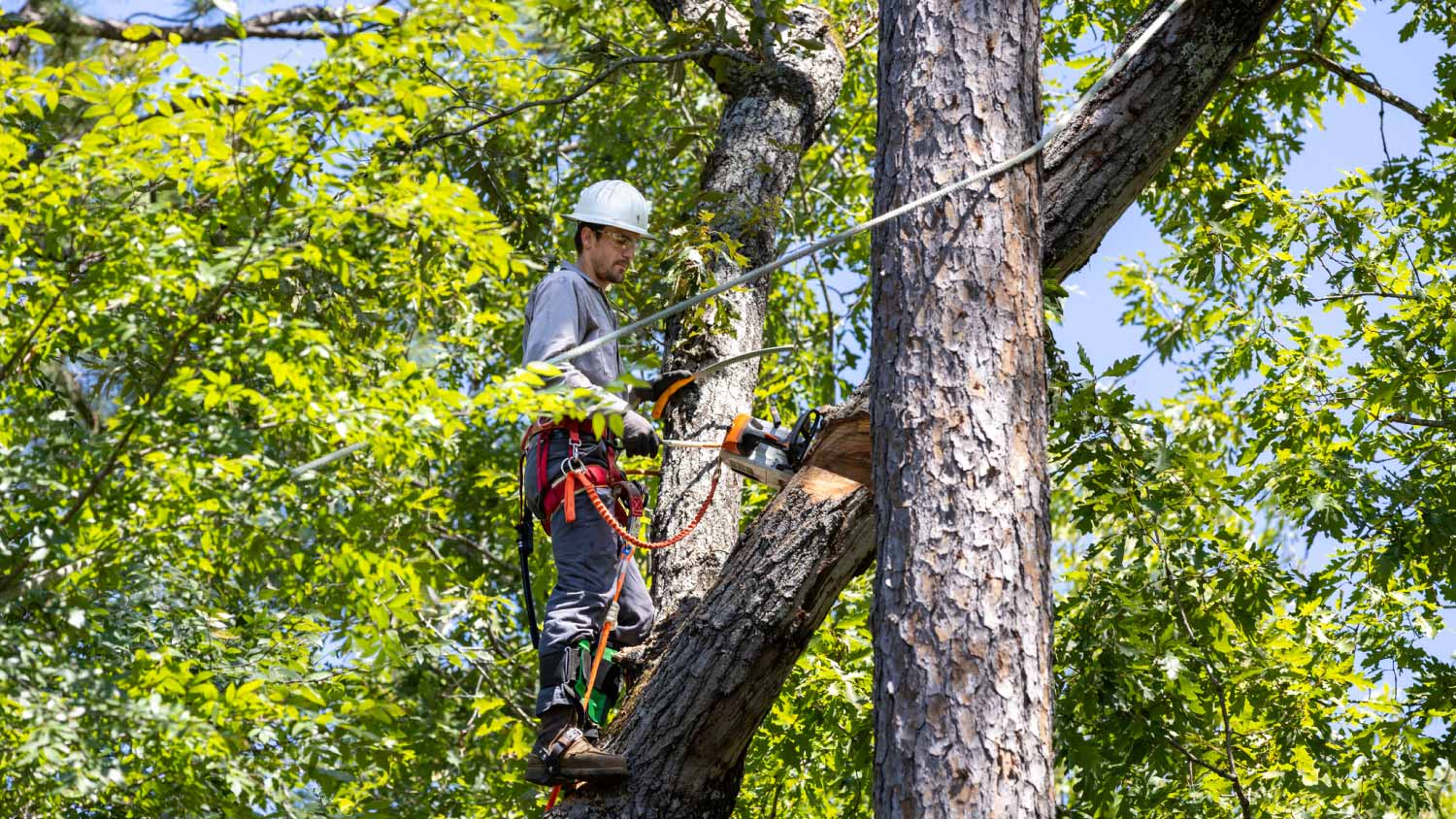
Trimming your bushes is one of the less costly aspects of landscaping, and it’s helpful to bundle many trimming services together to save money.
You don’t have to settle for being stumped


Whether your tree stump is in the middle of your lawn or near your fence, you can learn how to remove a stump. Not only can removing it improve your yard's aesthetic, but it can also prevent pests and fungi from taking up residence. This guide walks you through six methods to safely get rid of a stump and when to call in a stump removal pro.
Learning how to get rid of tree stumps can sound intimidating, but with the right tools and techniques, you can remove many stumps from your property. Here are the six best ways to remove a tree stump—all while staying safe.
You can let a stump rot naturally, but it can take three years or longer, depending on the type and size of the tree stump. Taking a few steps now can help speed up the rotting process.
With a power screwdriver, drill ⅝-inch holes in the surface and sides of the stump. Holes should be approximately three to five inches apart.
Bury the remainder of the stump in mulch, compost, or other organic matter.
Wait for the stump to deteriorate.
Use an ax or spade to break up the stump and dig out the pieces with a shovel.
Cover the area with soil or mulch.
Manually digging out a stump is best for small tree stump removal. The process is labor-intensive; only attempt it if you feel physically able. It is also best for small stumps.
Water the soil around the stump for one to two days leading up to stump removal. Wet the area enough to loosen the soil and roots while not making a muddy area to work in.
Cut aerial and in-ground anchor roots to weaken the stump's hold. Use an ax, root saw, or loppers to cut through exposed roots.
Dig under the stump with a digging bar. Lever the bar up and down and left to right to raise the stump and reveal new roots.
Cut the newly exposed roots with an ax, root saw, loppers, or the chisel end of the digging bar. With a shovel, dig around the stump and uproot it.
Fill the hole with soil.

Using a stump grinder to remove a tree stump is another quick method of disposal, but it will cost more money than the manual method. If you don’t already own a stump grinder, contact your local home improvement store to rent one or hire a professional stump grinder to tackle this dangerous task.
Grinding a stump can take care of larger stumps that are too difficult to dig up. Depending on the size, it can take anywhere from one to six hours to grind a stump. The grinder will create wood chips and a hole in the ground. Read and follow all safety guidelines, such as wearing protective goggles, earplugs, and work gloves.
Clear away the dirt and debris from the stump using a shovel or mattock.
Dig a trench around the stump, about 2 feet wide by 2 feet deep, removing as much dirt and rocks as possible. Cut any exposed roots with a lopper, ax, or root saw.
Using a chainsaw, cut off as much of the exposed top of the stump as possible so you’ll have less stump to grind. Ideally, the surface of the tree stump should be at ground level.
Using the hydraulic lever, raise the grinder a few inches above the stump.
Make sure the machine is level, then turn it on. Lower the grinder approximately 4 inches into the stump. Gradually allow the machine to move side to side with the lever.
Once on, lower the grinder a few inches into the stump and allow it to gradually move side to side with the lever.
Grind down about four inches into the stump, move the grinder forward, and repeat this process around the entire perimeter until the whole stump is approximately four inches below the ground.
Remove the remnants of the stump with a shovel or rake. Take out the wood chips if you plan to use them elsewhere on your property, or mix them in with soil. Then, fill in the hole with soil.
Stump grinders are high-risk tools that can accidentally propel objects and debris. When using a stump grinder, equip yourself with protective gear and thoroughly clear the area. Alternatively, hire a professional stump grinder to ensure your personal safety and professional-level results.

You can burn a stump to get rid of it, but check with your city and county laws first to see if it’s legal to do so in your area. You also want to ensure the fire won’t be near your home, utility lines, or other flammable items. Keep in mind that tree stumps that are dried out and dead for at least three years burn faster than fresh stumps that still have plenty of moisture.
Drill ⅝-inch holes about three inches deep across the stump’s surface with a power screwdriver. Place holes approximately every three to five inches.
Pour vegetable oil into the holes. Let the oil sit for 24 to 48 hours, then pour more vegetable oil into the holes.
Place charcoal bricks across the stump’s surface. Light the charcoal with a match or lighter. Supervise the fire at all times while you let the stump burn out. Keep a fire extinguisher on hand in case of an emergency.
Remove the remaining stump pieces and fill the hole with dirt.
If your stump is small, consider covering it with soil and regrading the area. Whether your stump is in your lawn or garden, you can hide it and allow it to naturally rot away over time.
Cut the stump as low to the ground as possible using a chainsaw if you haven’t already.
Cover the stump with soil or mulch. Spread more soil or mulch around the covered stump to create a gradual tapering off. Aim to grade the area with a subtle incline instead of a steep mound.
Use the backside of a rake to smooth the dirt or mulch. Place a piece of plywood on the new soil, then walk across it several times to compact the dirt.
Add new soil or mulch if needed and compact it down. Plant grass in the new soil if desired.
Stump softeners are herbicides specially formulated to kill a tree stump and its roots. Applying a stump softener to an unwanted tree stump can eliminate the need for heavy equipment and intensive labor, while also preventing the stump from growing back in the future. Keep in mind, though, that many stump softeners use chemicals that can harm surrounding wildlife. So, if possible, you may want to consider a natural alternative before going this route for stump removal.

Tree stumps are difficult to remove, but avoiding dangerous techniques can increase your chances of safe, successful stump removal.
Avoid pulling a stump with a truck, as it can cause serious injury and damage to your vehicle.
Don’t grind a stump with a chainsaw, as it can dull your chainsaw and damage it.
Don’t use a winch to remove a tree stump unless you’ve had technical training. The force when removing a stump could pose a serious risk of personal injury.
Check local laws and burn bans before burning a stump.
Removing a tree stump takes time, tools, and, depending on the method, intense physical labor. You can handle small stump removal yourself with the right technique and some patience. However, it may be best to hire a local stump removal professional if it’s a large stump or you have several stumps you’d like to remove. These stump removal pros have the right tools, skills, and equipment to get the job done safely and efficiently.
There are many reasons why you may want to remove a tree stump from your yard. Some common examples include unwanted regrowth, tripping hazards, pest or disease infestation, or it’s in the way of new landscaping projects. Plus, a leftover stump can attract tree fungus and draw necessary nutrients away from surrounding live trees and plants. In that case, it’s best to remove tree stumps quickly to avoid causing more damage to your yard.
On average, the cost to grind a stump ranges from $150 to $320 for the first stump and approximately $50 per additional stump. You can remove a stump yourself with a few tools, but it takes time and, in some cases, intense physical exertion. It’s worth investing in the services of a professional stump grinder to ensure it’s removed completely and safely.
From average costs to expert advice, get all the answers you need to get your job done.

Trimming your bushes is one of the less costly aspects of landscaping, and it’s helpful to bundle many trimming services together to save money.

Discover what the current average tree removal cost is based on different factors to know how much it will cost to take care of a dead or troublesome tree on your property.

The cost of tree stump removal depends on size, removal method, location, and more. Our guide will show you how much stump removal costs.

Follow these tips to learn how to find a good tree removal service. Doing a little research can help you save time and money when you need to say goodbye to your trees.

What is an arborist and do they cut down trees? Learn what an arborist is, the services they offer, and when to hire one.

Not sure what to do after stump grinding? Learn essential steps to take, like how to plant a new tree plus other ideas to utilize the space.